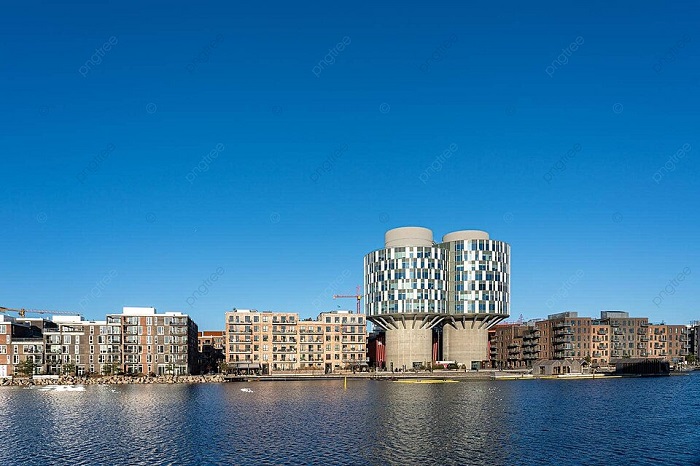-
10:00
-
09:00
-
16:30
-
11:50
-
11:20
-
07:30
-
10:50
-
08:30
-
08:00
Follow us on Facebook
The Five-Minute City Revolutionizing Urban Living in Denmark
In recent years, the concept of the "15-minute city" has stirred significant debate, with critics questioning its intentions and even alleging global conspiracies. Yet, far from the controversies, the city of Copenhagen in Denmark has quietly pioneered an even more ambitious model: the "five-minute city" in the emerging Nordhavn neighborhood. Here, this urban model emphasizes walkability, environmental sustainability, and social connection, creating a vibrant, car-free community that is reshaping the future of urban living.
Nordhavn, a former industrial zone in Copenhagen, has been transformed into a model of modern urban planning. Designed to accommodate 40,000 residents and workers by 2050, it is a testament to what happens when urban planning prioritizes human experience over vehicular infrastructure. Instead of focusing on roads for cars, the city was designed from the ground up to cater to pedestrians, cyclists, and public transport users. A new metro line, extensive cycle routes, and pedestrian-friendly streets ensure that all amenities—offices, schools, shops, and leisure spaces—are within a five-minute walk of each other.
The concept of the "five-minute city" stems from this focus on creating an environment where essential services and daily needs are easily accessible on foot. Around each metro station, planners defined a 400-meter radius—a distance easily covered in five minutes of walking. Within these zones, residents can access everything from grocery stores to cafés, schools, and offices, making it a truly local community.
 Beyond convenience, Nordhavn places a strong emphasis on environmental sustainability. Copenhagen has long been a leader in green initiatives, and Nordhavn is no exception. The neighborhood is carbon-neutral, with energy-efficient buildings, renewable energy sources, and cutting-edge infrastructure. For example, some of Nordhavn’s buildings have been repurposed from old industrial structures, like the Silo Tower, which was once used to store grain. This innovative reuse of buildings complements the area's goal to be environmentally responsible while maintaining historical significance.
Beyond convenience, Nordhavn places a strong emphasis on environmental sustainability. Copenhagen has long been a leader in green initiatives, and Nordhavn is no exception. The neighborhood is carbon-neutral, with energy-efficient buildings, renewable energy sources, and cutting-edge infrastructure. For example, some of Nordhavn’s buildings have been repurposed from old industrial structures, like the Silo Tower, which was once used to store grain. This innovative reuse of buildings complements the area's goal to be environmentally responsible while maintaining historical significance.
Social sustainability is another cornerstone of Nordhavn’s design. Public spaces encourage interactions, with wide cycle lanes and pedestrian-friendly streets ensuring that people are constantly in contact with each other. Local businesses, from design studios to bakeries, are carefully curated to foster a sense of community and avoid the homogenization seen in many urban developments. There are no international chains like Starbucks or McDonald's—only local businesses that contribute to the area’s unique character. This strategic retail mix helps create a dynamic urban environment that attracts a diverse range of residents and visitors.
The concept of community extends beyond business and retail. Residents of Nordhavn often speak with pride about their sense of belonging. Many report a strong sense of connection with their neighbors, with plenty of social activities such as book clubs, knitting groups, and community dinners. The neighborhood’s proximity to water further strengthens this bond—people come to Nordhavn not just to live but to experience a fulfilling lifestyle.
However, the five-minute city model is not without challenges. One concern is that such developments may lead to the creation of exclusive enclaves. While the neighborhood offers a high quality of life, property prices in Nordhavn are significantly higher than the Copenhagen average, making it less affordable for some. To counter this, a portion of the housing in Nordhavn is reserved for social housing, ensuring that key workers and lower-income residents are not priced out of the area.
 Nordhavn is still a work in progress, with much of the development yet to be completed. However, the neighborhood already exemplifies the principles of sustainable, walkable urban living. In the coming years, new public spaces and cultural hubs will further enrich the community, ensuring that Nordhavn remains a model for the future of cities.
Nordhavn is still a work in progress, with much of the development yet to be completed. However, the neighborhood already exemplifies the principles of sustainable, walkable urban living. In the coming years, new public spaces and cultural hubs will further enrich the community, ensuring that Nordhavn remains a model for the future of cities.
Nordhavn’s success is a reminder that the future of urban living may not be about futuristic technologies or radical innovations. Instead, it is about returning to the fundamentals of urban design that prioritize people over cars. It’s a return to the way cities were once built, with thoughtful design that fosters connection, sustainability, and quality of life—proving that the city of the future can also be the city of the past.



